Chinese multiple launch rocket systems of the 1970-1990s
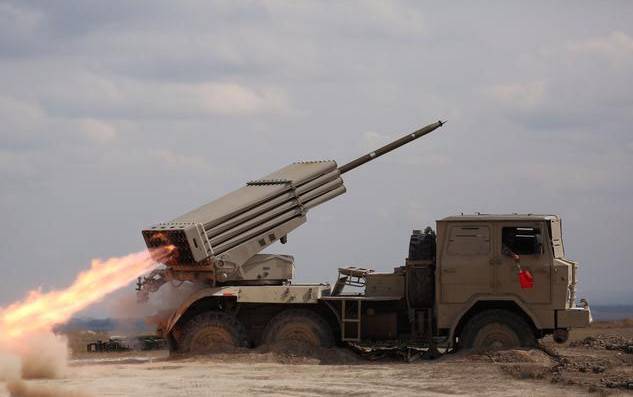
The "Cultural Revolution" had the most negative impact on the scientific and industrial development of China. From the second half of the 1960s to the mid-1970s, many high-tech defense programs were frozen in the PRC, and the production of a number of technologically sophisticated models of military equipment and weapons was discontinued. This was primarily due to the repressions against the scientific and technical intelligentsia, which in turn led to a drop in the level of production and technological discipline and disorganization of production.
This fully applies to the creation of new multiple launch rocket systems.
The key element of the MLRS is the missile. With outward simplicity and seemingly uncomplicated design, the process of designing and embodying new truly effective unguided rockets into metal is not a simple matter, requiring a certain scientific and technical base, a sufficiently high level of development of the chemical, metallurgical and metalworking industries. In addition to the light 107-mm Type 63, in the 1960s, the PLA did not receive any more type of MLRS, although the need for powerful and long-range rocket launchers was very great.
New rocket launchers in the PRC were put into mass production after overcoming the devastating consequences of the "cultural revolution". The creation of the MLRS in the PRC went in two ways: by copying the best foreign samples and creating our own.
Chinese 130mm multiple launch rocket systems
After the adoption of the 107-mm towed rocket launcher Type 63, the question arose of creating a larger caliber system based on it, with a projectile equipped with a more powerful warhead. Apparently, out of a desire to confuse enemy reconnaissance, the new self-propelled 19-barreled 130-mm multiple launch rocket system received the designation Type 63 (the same as the 107-mm towed installation).
An increase in the caliber and number of launch tubes led to an increase in weight, and therefore the 130-mm MLRS was produced only in a self-propelled version.
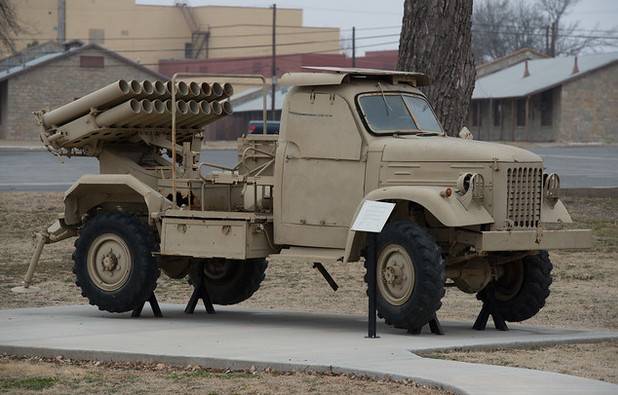
Self-propelled 130 mm MLRS Type 63
As a base for the 130-mm MLRS, the Nanjing NJ-230 all-wheel drive two-axle truck (the Chinese version of the GAZ-63) was originally used, in the rear of which the launcher itself was placed. The launch pipes were located in two rows: in the upper row - 10 pipes, in the lower - 9.
The guidance angles of the launcher were 75 ° to the right and to the left, the elevation was from zero to 50 °. In most cases, the firing was carried out by deploying the launcher at a sufficiently large angle from the axis of the vehicle. This was done in order to avoid jet damage to the cockpit. The duration of the volley is 15 s.
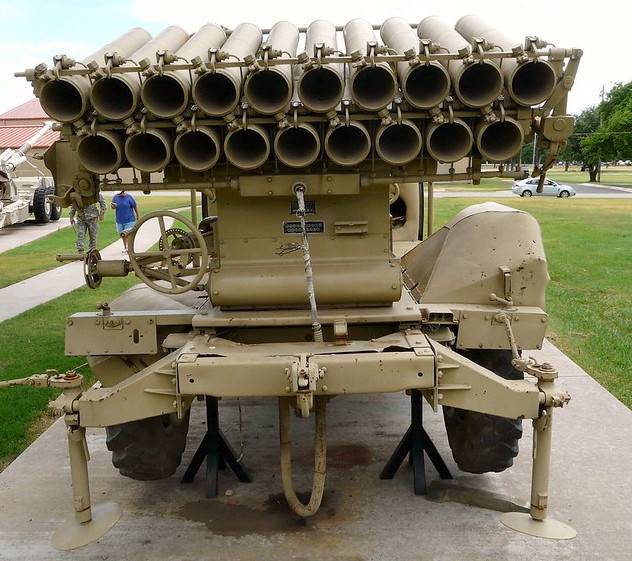
To increase the stability of the combat vehicle during firing, additional reclining supports were used. The car was serviced by a crew of 6 people. The maximum speed on the highway in the equipped form is 62 km / h.
The firing was carried out with unguided 130-mm rockets 1 mm long, which were actually enlarged copies of 050-mm rockets stabilized in flight by rotation.
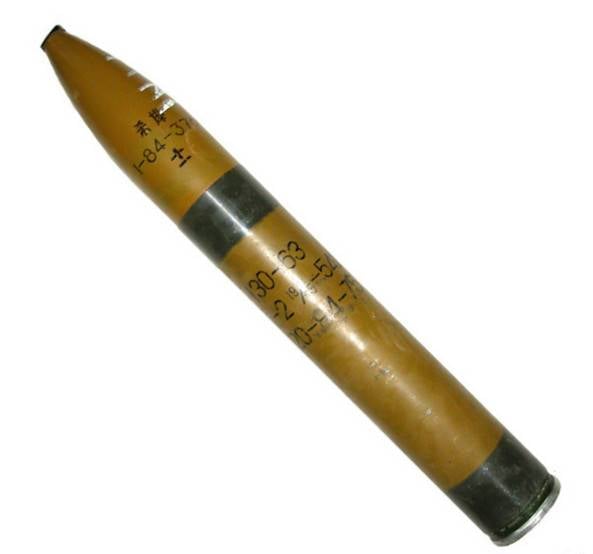
The high-explosive fragmentation projectile, which weighed 34 kg, had a firing range of 10 100 m and a maximum flight speed of 437 m / s. A warhead weighing about 11 kg contained 3 kg of explosives and, when detonated, yielded more than 1 lethal fragments, with a radius of 900 m.
The first samples were transferred for testing in the mid-1960s, and in 1967 the lead batch of 130-mm MLRS was sent to the troops. However, in the future, due to the destructive processes taking place in the country, the production of new installations slowed down. The mass production of the Type 63 self-propelled guns was launched only in the mid-1970s, after the political and economic situation in China had stabilized.
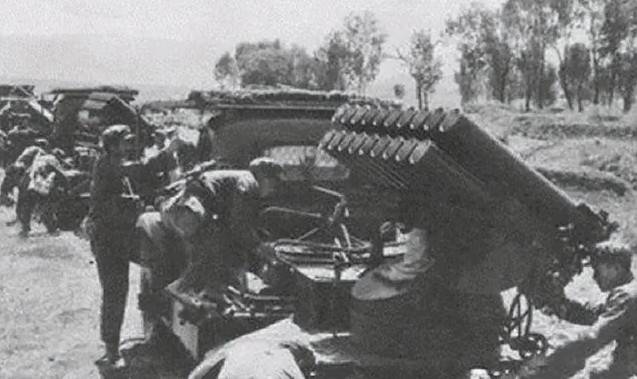
Although the 130-mm Chinese MLRS on the Nanjing NJ-230 chassis was inferior in its capabilities to the Soviet BM-14 and BM-21, it was actively used by the PLA as a means of fire reinforcement for infantry divisions until the early 1990s. The first serial 130-mm rocket artillery vehicles took part in the Vietnam-China War. Several dozen of these units were exported to Iraq, and at least one vehicle became a trophy for the American army.

MLRS Type 63-1
An improved rocket artillery combat vehicle based on the Dongfeng EQ1980 truck that appeared in 240 with the ability to carry additional ammunition was designated Type 63-1.
The Chinese 130-mm MLRS was superior to the 107-mm installation, but its maximum firing range was still insufficient, and the dispersion of shells at the maximum distance was too significant. In this regard, the most effective was shooting at visually observed targets, at a distance of no more than 6 m.
In parallel with the 130-mm rocket artillery combat vehicle on the chassis of the Nanjing NJ-230 truck, the development of an MLRS, intended for arming rocket battalions, began. tank regiments.
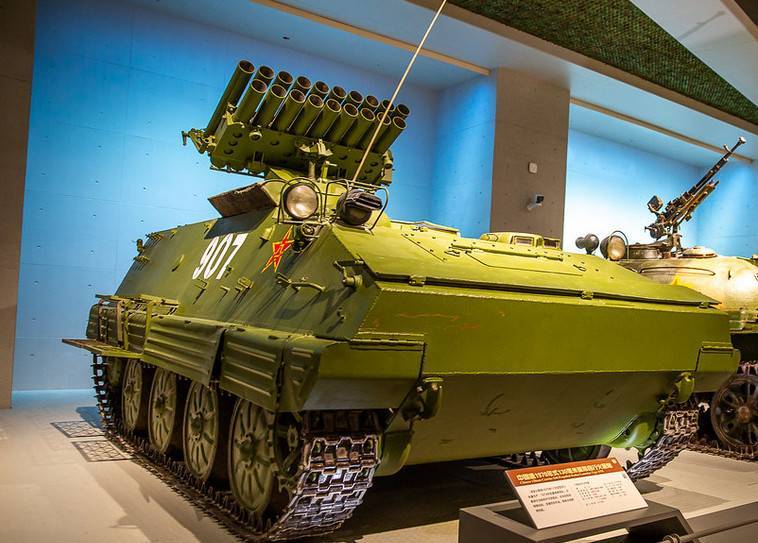
MLRS Type 70 at the Military Museum of the Chinese Revolution
The basis for the Type 70 MLRS (WZ-302) was the Type 63A (YW531) amphibious tracked amphibious armored personnel carrier, which was put into mass production in the late 1960s. Reservation of the vehicle in the frontal projection provided protection against armor-piercing rifle bullets, the side armor protected from small fragments. Diesel engine with a capacity of 260 liters. With. accelerated on the highway to 60 km / h, the speed afloat - 6 km / h. Vehicle weight in combat position - 12,6 tons. Crew - 4 people. Additional ammunition was transported inside the hull.
Since the MLRS on a tracked chassis was supposed to provide fire support to tank units, the Type 70 was not inferior in cross-country ability and speed to the Type 59 medium tank (the Chinese analogue of the Soviet T-54).
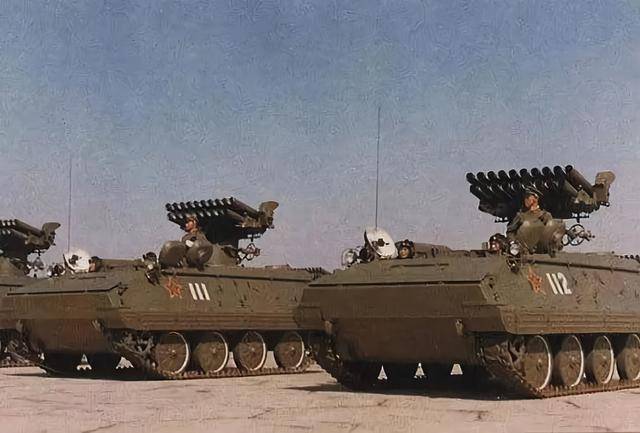
Mass deliveries of MLRS Type 70 to the troops began in the early 1980s. In total, about 300 vehicles were built.
In 1982, the Type 82 MLRS was officially adopted on the chassis of the Yanan SX250 three-axle off-road truck, which replaced the 130-mm Type 63 installation based on the Nanjing NJ-230 car. The mass of the vehicle in the firing position is about 8 tons. The maximum speed is 75 km / h.
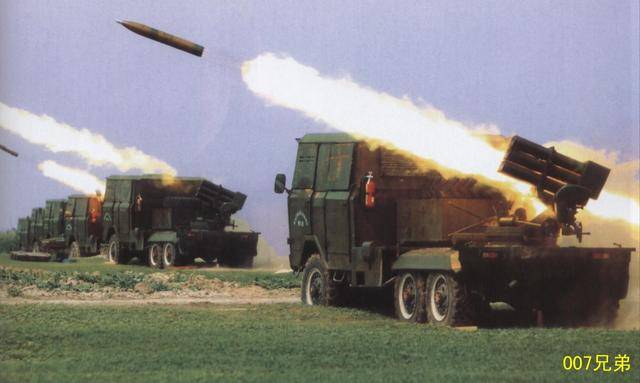
The fire is conducted by the Type 82 MLRS battery
For firing from the Type 82 MLRS, the same 130-mm turbojet projectiles were used. But the number of launch tubes at the installation increased to thirty (three horizontal rows of ten each). Compared to the original truck, the cab has been enlarged. Behind the driver's and commander's workplaces there were two rows of seats for five crew members. A metal box was placed behind the rear edge of the cockpit for transporting 30 rockets. Thus, without the help of a transport-loading vehicle, it was possible to fire two volleys in a row with a reloading break of 7 minutes.
In addition to the existing 130-mm high-explosive fragmentation projectiles, the Type 82 rocket launcher ammunition introduced fragmentation projectiles with a warhead equipped with 2 steel balls, an incendiary projectile with white phosphorus, and a projectile with a firing range increased to 600 m. In addition, 15-mm rockets were considered from the very beginning as a means of delivering chemical warfare agents.
An artillery unit with thirty tubular guides was also installed on tracked armored personnel carriers. This machine, intended to replace the Type 70 MLRS, is known as the Type 85.

MLRS Type 85
The Type 85 MLRS, like the Type 70, was used in the rocket artillery divisions of tank regiments, but the Type 85 was much inferior to the Type 70 in the number of built copies.
The Chinese armed forces operated 130 mm MLRS on wheeled and tracked chassis until 2010. After that, they were supplanted by modern combat vehicles of rocket artillery.
Chinese 122mm multiple launch rocket systems
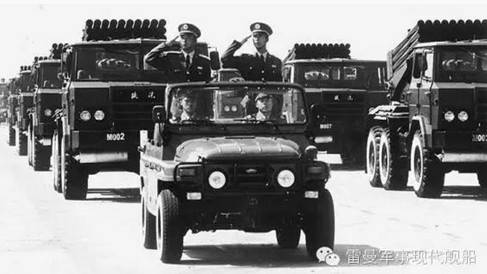
Chinese 130-mm rocket launchers by the standards of the 1960-1970s had good characteristics. In terms of ease of use, accuracy and maximum firing range, they outperformed the Chinese copies of the Soviet Katyusha, firing 132-mm feathered shells. But in connection with the decline in Chinese science and technology caused by the "cultural revolution", it was possible to establish a truly mass production of multiple launch rocket systems, and most importantly, 130-mm turbojet projectiles, only at the end of the 1970s.
By that time, the 130-mm MLRS in service with the PLA were no longer the last word in military technology and, in a number of parameters, were seriously inferior to systems of a similar purpose created in the USSR.
In 1969, during armed clashes on the Soviet-Chinese border, PLA servicemen experienced the crushing power of the BM-21 Grad MLRS. At that time, China did not have multiple launch rocket systems that could match the characteristics of the Soviet Grad, and its use made a great impression on the Chinese command. The desire of the Chinese generals to get at their disposal an installation with the effectiveness of the BM-21 became quite logical, and the Chinese intelligence made serious efforts in this direction.
Fortune smiled at the Chinese in the late 1970s. A number of domestic authors claim that the PLA soldiers managed to capture the 122-mm Grad rocket launcher at the beginning of 1979 during the Sino-Vietnamese war. However, this version seems unlikely, since the main burden of the hostilities in the areas bordering the PRC was borne by the Vietnamese border guards and militias. The BM-21 Grad rocket artillery regiment entered the battle on March 5, 1979, on the same day China officially announced the termination of the offensive and the beginning of the withdrawal of troops.
Modern Chinese sources say that the Chinese representatives managed to secretly negotiate with Israel on the supply of several captured BM-21 installations and 122-mm rockets captured by Israeli forces from the Arabs. It is also possible that China bought Soviet-made Grads from Egypt. Just at that time, on the basis of anti-Sovietism, there was a rapprochement between the PRC and the United States and its allies. As part of military-technical cooperation, which ended in 1989, Western countries transferred a number of modern models of military equipment to China, and American intelligence agencies actively exchanged information with Chinese intelligence.
In the mid-1980s, the PLA entered service with the first Chinese version of the Grad, the Type 81 MLRS (PHL-81). The package with 40 tubular guides was mounted on a three-axle Nanjing CQ260 four-wheel drive truck (copy of the French Berliet GBU-15).
The combat vehicle's curb weight was 15 100 kg. The maximum speed of the loaded installation on the highway is up to 70 km / h. Calculation - 7 people. The length of the tubular launcher is three meters. The range of elevation angles: from 0 to + 55 °, the horizontal firing sector to the right and left - 70 °. The duration of the volley is 20 s.
For firing, 122-mm rockets of a caliber similar to those used for the BM-21 combat vehicle are used. Thanks to copying Soviet missiles, the Chinese were able to master a new technology for stabilizing the projectile - due to the folding tail. This solution allows you to combine the compactness of the rocket in the transport position and acceptable firing accuracy.
The first serial high-explosive fragmentation projectile weighed 66,8 kg, muzzle velocity - 49,5 m / s, maximum firing range - 20 m. , smoke, cluster and chemical shells. Due to the use of new fuel formulations, Chinese specialists were able to consistently increase the firing range to 500, 1990 and 81 km.
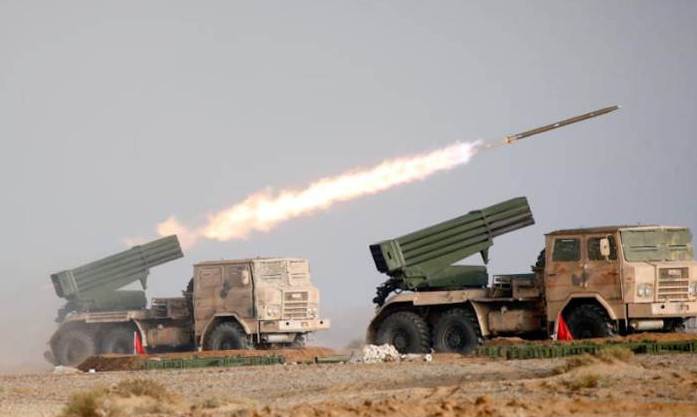
Recharging was carried out by the forces of the calculation or using a transport-charging machine. In the latter case, it took 8 minutes.
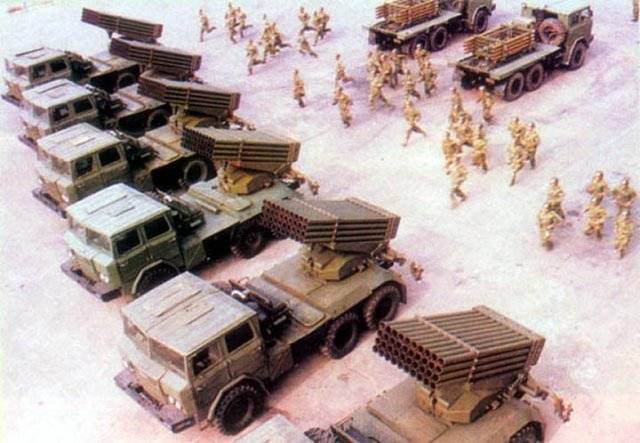
Battery MLRS Type 81. In the background - TZM
The Type 122 81-mm rocket launchers entered the rocket artillery regiments, in which they seriously pushed the Type 63 and Type 82 MLRSs on a wheeled chassis. In total, 351 Type 81 combat vehicles were delivered to the customer.
After the adoption of the Chinese clone "Grad" on the basis of an all-terrain vehicle, work began on the creation of a 122-mm MLRS on a tracked chassis, capable of operating in the same battle formations with tanks. In addition, the requirement was put forward to ensure the possibility of transporting additional ammunition on the launcher.
In 1989, tests of the Type 89 (PHZ-89) MLRS began on the WZ-321 unified tracked chassis, which was previously used for the 152-mm Type 83 self-propelled guns. weapons and artillery shell fragments.
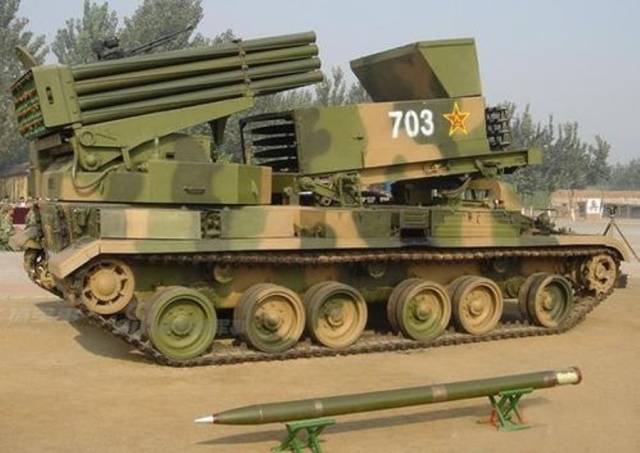
MLRS Type 89 next to a 122-mm rocket
In the rear of the Type 89 MLRS there is a package of guides, and in front of it is a second set of rockets, covered with a lightly armored casing. Thanks to this solution, the crew always has 40 additional shells at their disposal, which reduces the dependence on wheeled TPM, and the reload time was reduced to 3 minutes.
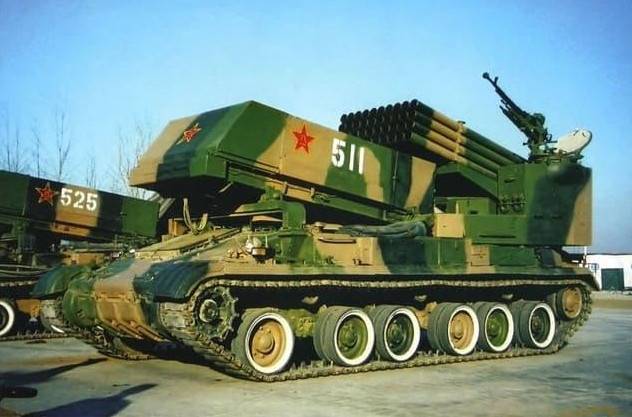
To the left of the package with guides, on the same base there is an armored gunner's wheelhouse, next to the hatch of which a 12,7 mm Type 54-1 machine gun is installed. The lifting and turning mechanisms allow directing the artillery unit in the vertical plane in the range of angles from 0 ° to + 55 °. The horizontal angle of fire is 168 °.
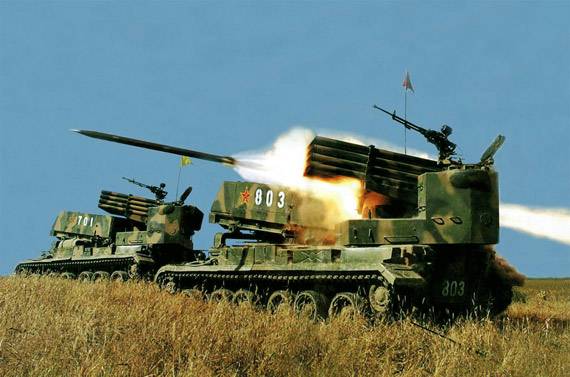
It is reported that a centralized combat control system is used to guide the actions of the battery and issue target designation, transmitting data from the command vehicle to the launchers via radio.
The mass of the installation in the firing position is about 30 tons. The maximum speed on the highway is 55 km / h. The crew of the car is 4 people.
At present, Type 89 combat vehicles have completely supplanted the 130-mm MLRS on the Type 63A chassis in jet divisions intended for fire support of tank units. Rocket artillery vehicles Type 89 are used only by the PLA and have not been exported.
The developments obtained in the creation of the Type 89 tracked rocket system were used in the mid-1990s in the design of the new Type 90 wheeled MLRS, which was intended to replace the Type 81.

MLRS Type 90
For this rocket artillery vehicle, the Tiema XC2030 chassis (a copy of Mercedes-Benz 2026) with a 6x6 wheel arrangement is used. It was possible to place a package of guides and a mechanized rack with spare ammunition for rockets on it. A fire control system is also used, similar to that used on the Type 89. The maximum elevation angle of the launcher is 55 °. Horizontal guidance –102 ° to the left and right of the vehicle axis. On the highway, the car can accelerate to 85 km / h. Calculation - 5 people.
To stabilize the combat vehicle when firing, it is equipped with hydraulic jacks. The artillery unit is guided remotely using the on-board control panel or by commands broadcast over the radio network. The combat vehicle is equipped with an automated reloading system, which consists of a lift and a feed mechanism. The platform with spare shells can be rotated 90 °.
In the stowed position, the package with guides and spare ammunition are covered with a folding awning, and the MLRS does not outwardly differ from a conventional truck. For this, on the cargo platform with loading equipment and a launcher, there are several moving U-shaped supports on which an awning is attached. Before the salvo, it gathers in front of the platform. After shooting, the calculation proceeds in the reverse order.
The flip side of the increased combat capabilities of the Type 90 MLRS was the high cost. In 2001, the price of one combat vehicle on the foreign market was more than $ 800. Compared to the Type 000 MLRS, the improved Type 81 became heavier by about 90 tons. The turning angle increased, and the passability on soft soils deteriorated.
On the basis of the Type 90 combat vehicle, several improved modifications have been created.
MLRS Type 90A (PHL-90A) on the Tiema XC2200 chassis (a copy of the German 8-ton truck Mercedes-Benz 2026) received a computerized control system with external sensors and satellite navigation equipment. The ammunition complement includes missiles with high-explosive fragmentation and fragmentation incendiary and cluster warheads, with a firing range of up to 40 km.
MLRS Type 90B is housed on the Beifang Benchi 2629 chassis with an extended cab. Added the ability to use guided missiles at the end of the trajectory, improved communications and command and control.
Thus, it can be stated that the Chinese did not confine themselves to simply copying the Grad MLRS and its shells. On the basis of the Soviet BM-21, the PRC created a number of very advanced 122-mm rocket launchers and new long-range missiles equipped with various warheads.
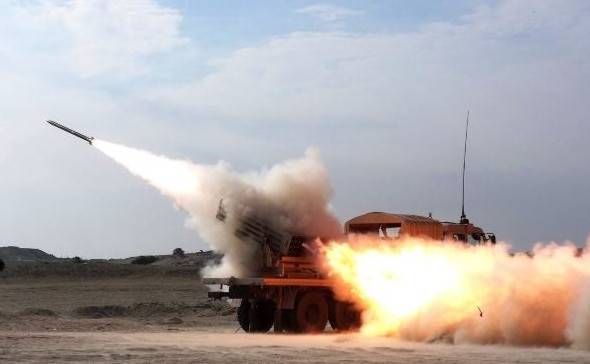
Currently, the PLA missile and artillery units have about 600 Type 81, Type 89 and Type 90 MLRSs.
The Chinese 122-mm MLRS is a direct competitor to the BM-21 Grad in the world arms market. They have been shipped to Myanmar, Gabon, Ghana, Democratic Republic of the Congo, Indonesia, Cambodia, Mauritania, Mali, Nigeria, Peru, Sri Lanka and Chad. Chinese rocket launchers Type 81 and Type 90 have been used in a number of armed conflicts, demonstrating efficiency at the level of the Soviet BM-21.
Chinese 273mm multiple launch rocket systems
During the Cold War, in addition to direct copying of foreign samples, Chinese designers, with varying success, tried to independently create heavy multiple launch rocket launchers. One of the samples brought to the stage of mass production was the 273 mm MLRS Type 83 (WM-40).
This system belongs to the first generation of Chinese MLRS, its development began in parallel with 107 and 130-mm rocket launchers. However, due to the need to solve a large number of tasks that turned out to be too difficult for Chinese science and industry, the practical implementation of the project began only in 1979.
The task of reliably hitting point targets with a solid-propellant rocket, with a conventional warhead at a distance of up to 40 km, about half a century ago, was practically insoluble. Even at the stage of calculations, it became clear that within the framework of the technologies existing at that time, the required result could not be achieved.
Experienced large-caliber "turbojet" projectiles were tested in the PRC, and during the tests it turned out that due to the loss of a part of the gases for the rocket spin-up, the power of the solid-propellant jet engine is not consumed optimally. Therefore, it was decided to use a rocket that rotates in flight due to a slight tilt of the stabilizers. On tests, it was possible to achieve a circular probable deviation of 1,2% and 0,7% in azimuth and range.
Despite many problems, the development of the 273-mm MLRS continued, and in 1984 this system was put into mass production under the designation Type 83.
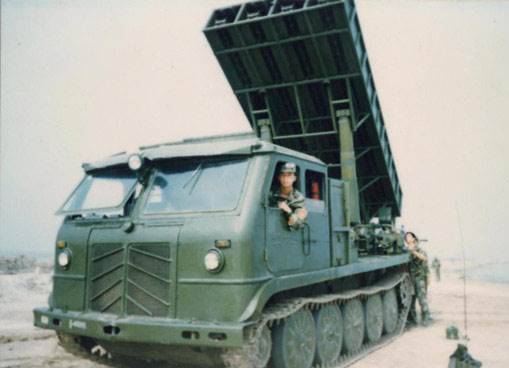
MLRS Type 83
The self-propelled launcher on the chassis of the Type 60-1 tracked tractor had a box-shaped block of guides for 4 unguided rockets. The heavy weight limited the horizontal guidance angles to 20 degrees in both directions. The vertical guidance angles were 5–56 °. Shooting was carried out in single shots or in a volley. With the use of TPM, the installation could be recharged in 20 minutes.
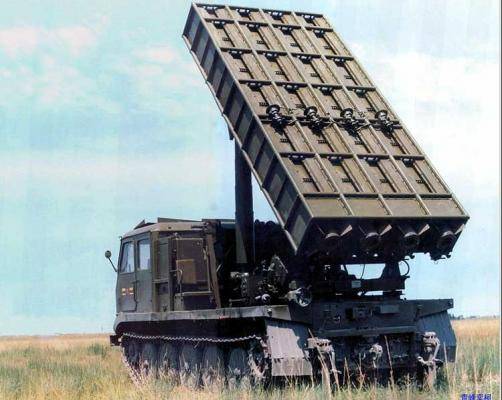
When driving on the highway, the launcher weighing 17,6 tons developed a maximum speed of 60 km / h. On rough terrain, it showed good cross-country ability and was able to overcome walls up to 0,6 m high and ditches 2,2 m wide.Without preliminary preparation, the launcher forced fords up to 1 m deep.
The 273-mm feathered rocket with a length of 4,7 m and a mass of 484 kg carried a 138-kg warhead. The maximum firing range was a little over 40 km. In flight, the projectile developed a maximum speed of 811 m / s.
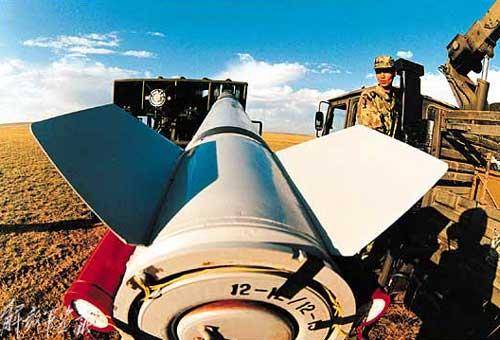
Initially, the ammunition load included only high-explosive missiles, but due to the small number of missiles in a salvo and significant dispersion when firing at maximum range, “special warheads” - chemical and nuclear - could be quite effective. Acceptable results could be achieved using a cluster warhead.
The production of 273 mm Type 83 rocket launchers was completed in 1988. They were in service until the end of the 1990s.
The Chinese military was not satisfied with the characteristics of the 273-mm Type 83 installations. In this connection, an attempt was made to radically modernize in terms of increasing mobility, increasing the range and accuracy of fire, fire performance, and expanding the range of ammunition.
In the mid-1990s, the production of a new 273-mm multiple launch rocket system WM-80 began on the chassis of a TAS5382 truck with a 4x4 wheel arrangement.
The mass of the installation in the firing position is 34 tons. When driving on the highway, the launcher develops a speed of up to 70 km / h and has a fairly high cross-country ability. Calculation - 5 people.
The ready-to-use ammunition load has been doubled to 8 missiles. The launcher has a swing frame with two packages of rockets with four guides each. The elevation angle of the guides is 20-60 °, the horizontal firing sector is 20 ° to the right and left of the axis of the combat vehicle.
After launching the rockets, the packages are removed from the launcher using the transport-loading machine and replaced with new ones in 8 minutes.
A rocket with a launch weight of 505 kg is capable of delivering a 150-kg warhead to a range of up to 80 km. The maximum flight speed is 1 m / s, the flight time to the maximum range is 140 s.
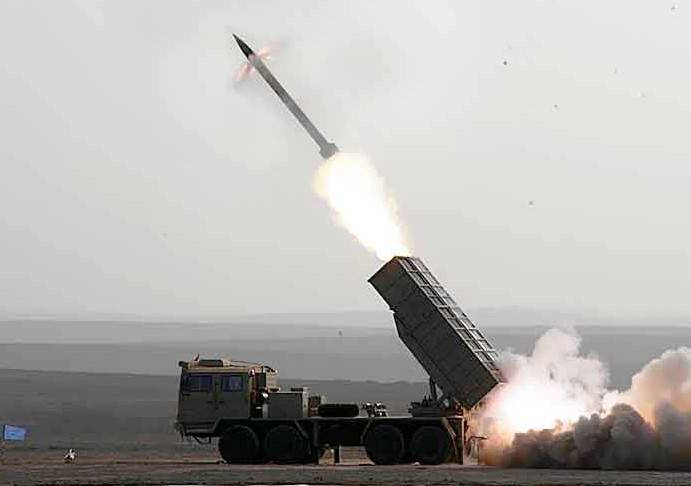
The feathered projectile is additionally stabilized in flight by rotation. According to the manufacturer, unguided rockets of the WM-80 system have a circular deviation of about 1% when fired at maximum range. The ammunition load includes rockets with high-explosive fragmentation and thermobaric warheads, as well as cluster, equipped with 380 HEAT-fragmentation submunitions.
It seems that the MLRS WM-80 has good characteristics and significant modernization potential. However, after careful testing and experimental operation, the Chinese military refused to adopt this system, and it was supplied only for export. Reactive systems WM-80 were acquired by Bangladesh, Jordan and Sudan. Four combat vehicles allegedly ended up in the United States, where they were thoroughly studied. Armenia received 8 vehicles and handed over half to the armed forces of Nagorno-Karabakh.
During the hostilities, the Armenian MLRS WM-80 could not prove themselves. Two cars were destroyed on the march by Azerbaijani drones, two more - managed to shoot back at enemy positions several times. High-explosive fragmentation shells exploded in an open field without causing damage to the enemy, and cluster submunitions did not work.
Chinese 302mm multiple launch rocket systems
In addition to the development of the 273-mm Type 83 and WM-80 MLRS, attempts were made in China to create multiply charged rocket systems of an even larger caliber.
So, in the late 1980s, work began on the 302-mm heavy installation WS-1, designed to strike at the most important targets located deep in the enemy's defense: large military bases, places of concentration of troops, launchers of missile systems, airfields, transport hubs , administrative and industrial centers.
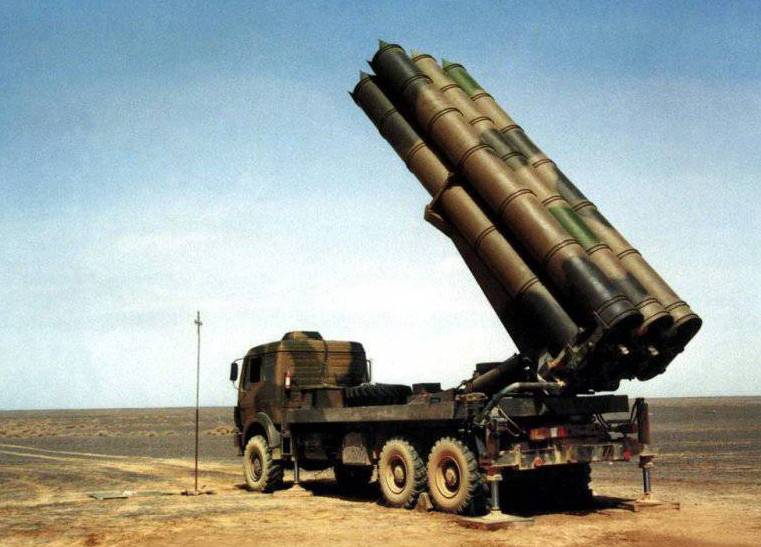
MLRS MLRS WS-1
In 1990, the first WS-1 MLRS entered trials. In 1993, an upgraded WS-1B system with an increased firing range was demonstrated.
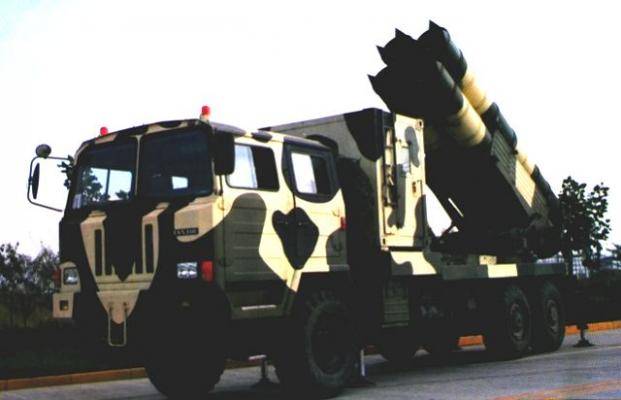
MLRS WS-1B
The launcher is a package of 4 cylindrical rails mounted on the chassis of a Tiema XC2200 6x6 truck.
The missile package is guided by hydraulic drives. Manual override of hydraulic drives is provided. Guidance of the package of guides is provided vertically in the range from 0 to 60 ° and in the 60 ° sector from the longitudinal axis of the launcher. The transfer time from traveling to combat position is 20 minutes. Crew - 3 people.
The MLRS battery WS-1B includes: a mobile command post, 5-8 launchers and the same number of transport-loading vehicles with 20 rounds of ammunition each.
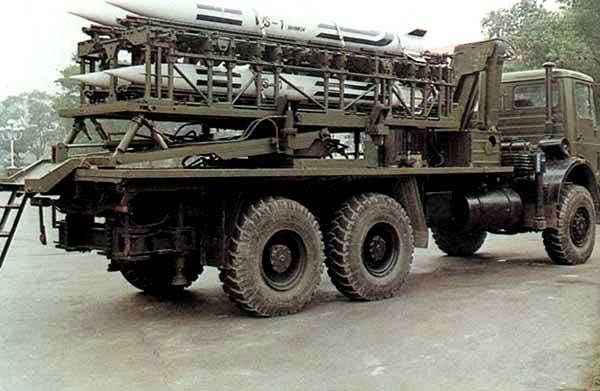
Transport and loading vehicle MLRS WS-1B
The command post is equipped with communication equipment for transmitting digital data and voice messages, navigation aids, a meteorological complex and night vision devices. There is a modern digital fire control system, equipment control and diagnostics means.
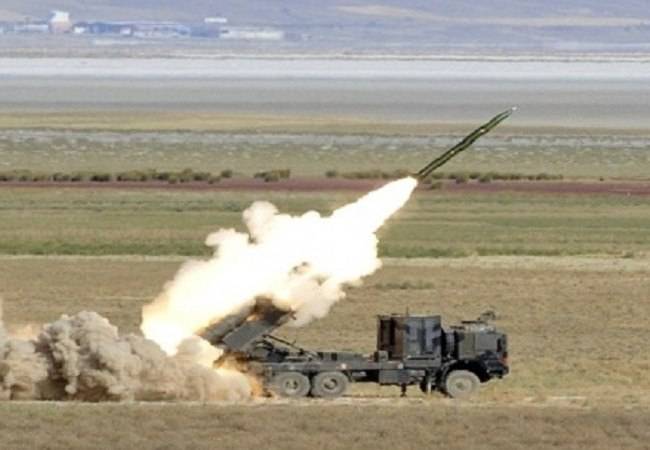
The WS-1 rocket with a launch weight of 524 kg was equipped with a 150 kg warhead. He developed a speed corresponding to the number of 4,2 M, and a maximum range of 100 km. In flight, the rocket was stabilized by the tail unit with the blades set at an angle to the longitudinal axis to ensure rotational motion. The circular probable deviation is about 1% of the range.
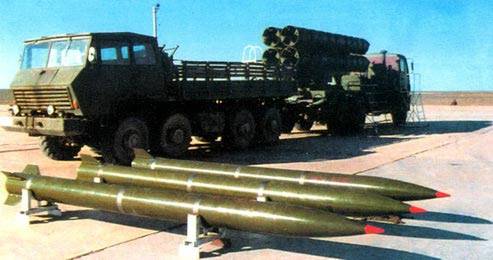
The WS-1B projectile with an upgraded solid-propellant jet engine with a starting weight of 708 kg and a 150-kg warhead is capable of striking targets at ranges of up to 180 km. This 302-mm rocket can be equipped with various types of warheads: high-explosive fragmentation, cluster and volume-detonating warheads. High-explosive fragmentation warhead is equipped with 70 kg of explosives of increased power. The cassette warhead is equipped with 466 HEAT-fragmentation submunitions with 70-mm armor penetration.
MLRS WS-1 and WS-1B were not adopted by the PLA.
Turkey became the only buyer of this system. In 1996, the Chinese company CPMIEC and the Turkish Roketsan entered into an agreement on the joint development and manufacture of an analogue of the Chinese MLRS WS-1B, which received the Turkish name Kasirga. The contract value was $ 150 million. CPMIEC supplied in 1997 a WS-1B MLRS battery (5 combat vehicles) and provided technical assistance in organizing the independent production of 5 more upgraded batteries. Later, licensed production was organized and MLRS WS-1B under the designation Jaguar.
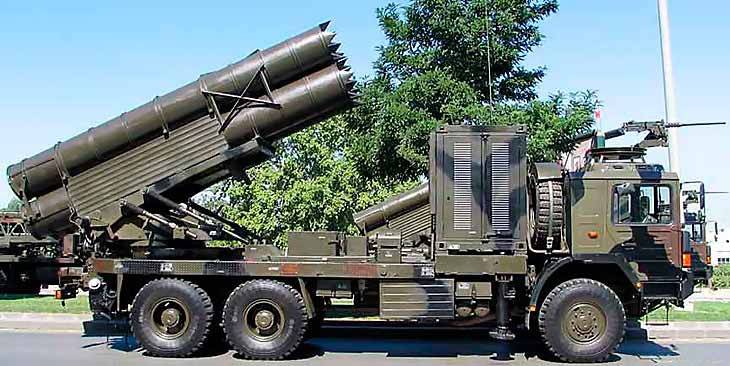
MLRS Kasirga
The wheelbase for the Turkish Kasirga MLRS was a German off-road vehicle from MAN with a 6 × 6 wheel arrangement with a carrying capacity of 10 tons. A machine gun or a 40-mm automatic grenade launcher can be mounted on the roof of the vehicle for self-defense.
To be continued ...
- Linnik Sergey
- Multiple launch rocket systems used by Chinese People's Volunteers in the Korean War
Chinese multiple launch rocket systems of the 1950-1970s
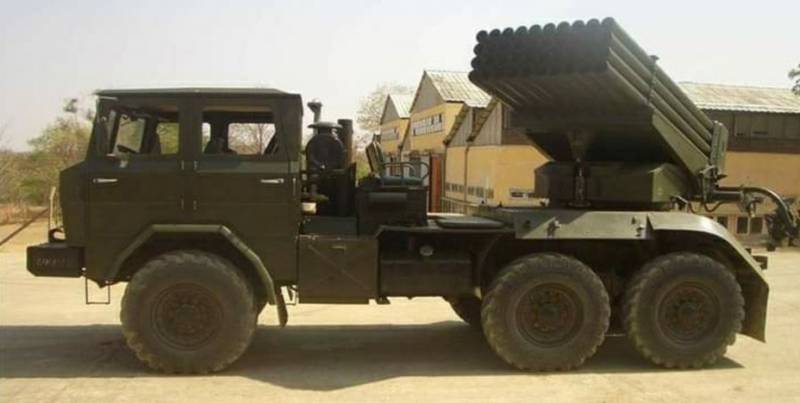
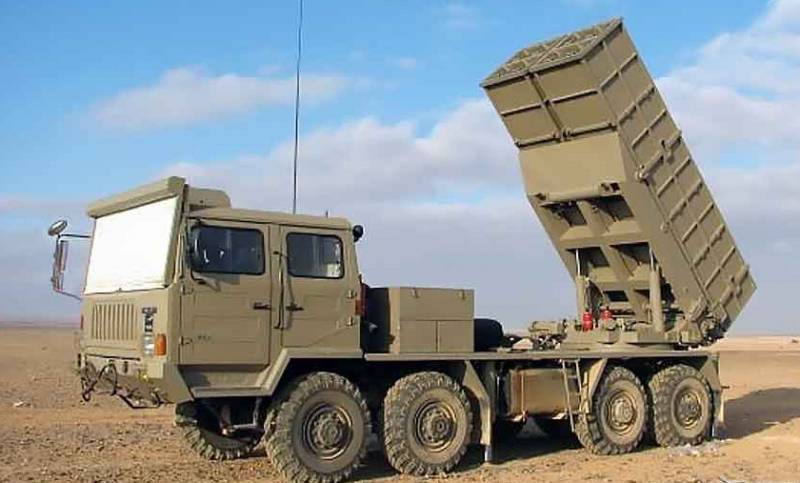
Information